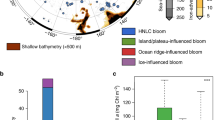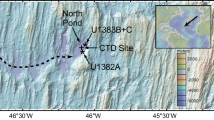Abstract
The circulation of seawater through newly formed ocean crust at mid-ocean ridge spreading centres is important in the oceanic heat and chemical budgets. The heat transfer in submarine hydrothermal systems accounts for ˜25% of the total global heat loss1. The transfer of mass resulting from basaltic alteration affects the geochemistry of seawater2 and is responsible for the formation of ore deposits on and beneath the seafloor3. Various geophysical techniques have been employed in efforts to determine the heat output from hydrothermal vent fields4–9; however, the magnitudes of the heat and chemical fluxes through these systems remain uncertain. Here we introduce a geochemical approach for estimating the flux from a vent field based on radon (222Rn) measurements in the overlying effluent plume. This method was applied successfully in September 1986 during a 23-day expedition to an active vent field on the 170-km Endeavour segment of the Juan de Fuca Ridge (Fig. la). We estimate the heat flux from this site to be l–5×l09 W.
This is a preview of subscription content, access via your institution
Access options
Subscribe to this journal
Receive 51 print issues and online access
$199.00 per year
only $3.90 per issue
Buy this article
- Purchase on Springer Link
- Instant access to full article PDF
Prices may be subject to local taxes which are calculated during checkout
Similar content being viewed by others
References
Sclater, J. G., Jaupart, C. & Galson, D. J. geophys. Res. 86, 11535–11552 (1981).
Edmond, J. M. et al. Earth planet. Sci. Lett. 46, 1–18 (1979).
Hekinian, R. et al. Science 207, 1433–1444 (1980).
MacDonald, K. C., Becker, K. Spiess, F. N. & Ballard, R. D. Earth planet. Sci. Lett. 48, 1–7 (1980).
MacDonald, K. C. in Hydrothermal Processes at Seafloor Spreading Centers (eds Rona, P. et al.) 27–51 (Plenum, New York, 1983).
Converse, D. R., Holland, H. D. & Edmond, J. M. Earth planet. Sci. Lett. 69, 159–175 (1984).
Baker, E. T. & Massoth, G. J. Earth planet. Sci. Lett. 85, 59–73 (1987).
Crane, K. C. et al. J. geophys. Res. 90, 727–744 (1985).
Little, S. A., Stolzenbach, K. D. & von Herzen, R. P. J. geophys. Res. 92, 2587–2596 (1987).
MERGE Group. EOS 65, 1111 (1984).
Hammond, S. R. et al. EOS 65, 1111 (1984).
Lupton, J., Delaney, J., Johnson, H. P. & Tivey, M. EOS 65, 975 (1984); 66, 929 (1985).
Lupton, J., Delaney, J., Johnson, H. P. & Tivey, M. Nature 315, 621–623 (1985).
Kadko, D. & Lupton, J. E. EOS 65, 974 (1984).
Speer, K. G. thesis, WHOI-MIT (1988).
Dymond, J., Cobler, R., Gordon, L., Biscaye, P. & Mathieu, G. Earth planet. Sci. Lett. 694, 417–429 (1983).
Kadko, D. & Moore, W. Geochim. cosmochim. Acta 52, 659–668 (1988).
Author information
Authors and Affiliations
Rights and permissions
About this article
Cite this article
Rosenberg, N., Lupton, J., Kadko, D. et al. Estimation of heat and chemical fluxes from a seafloor hydrothermal vent field using radon measurements. Nature 334, 604–607 (1988). https://doi.org/10.1038/334604a0
Received:
Accepted:
Issue Date:
DOI: https://doi.org/10.1038/334604a0
This article is cited by
-
Development of a sparging chamber for field radon analysis
Journal of Radioanalytical and Nuclear Chemistry (2013)
-
Constrained circulation at Endeavour ridge facilitates colonization by vent larvae
Nature (2003)
-
Anomalous CH4 and NH4+ concentrations at an unsedimented mid-ocean-ridge hydrothermal system
Nature (1993)
-
Helium/heat ratios and deposition temperatures of sulphides from the ocean floor
Nature (1992)
-
Changes in submarine hydrothermal 3He/heat ratios as an indicator of magmatic/tectonic activity
Nature (1990)
Comments
By submitting a comment you agree to abide by our Terms and Community Guidelines. If you find something abusive or that does not comply with our terms or guidelines please flag it as inappropriate.



